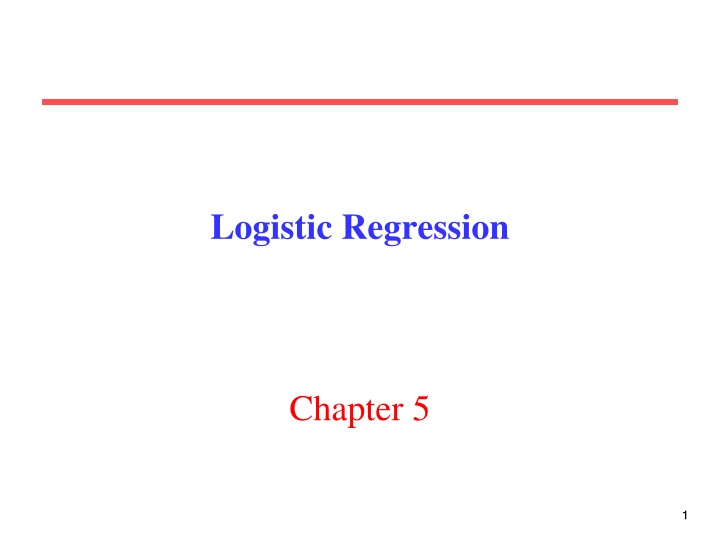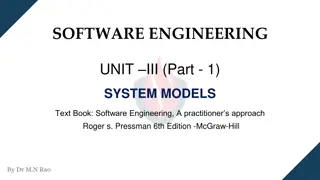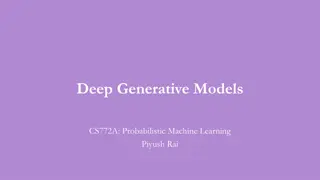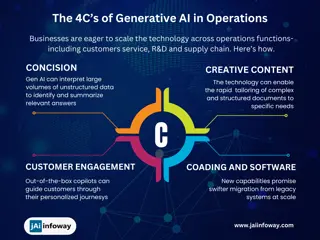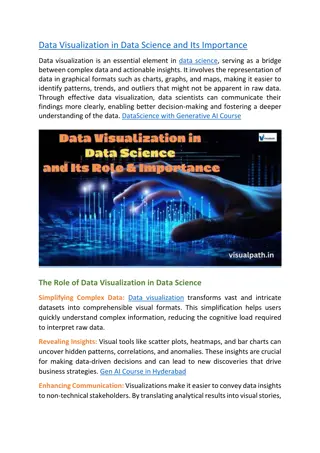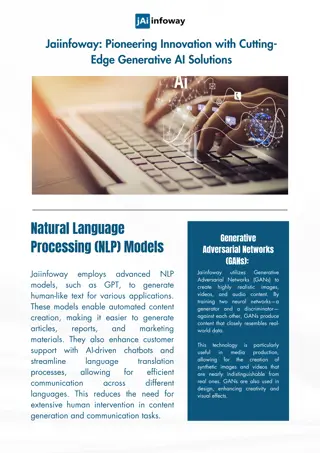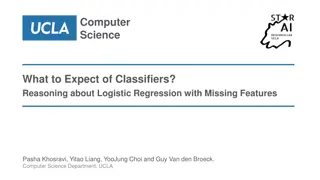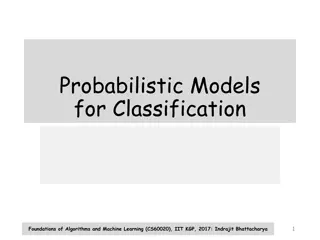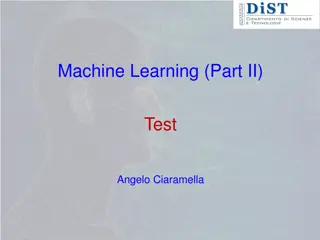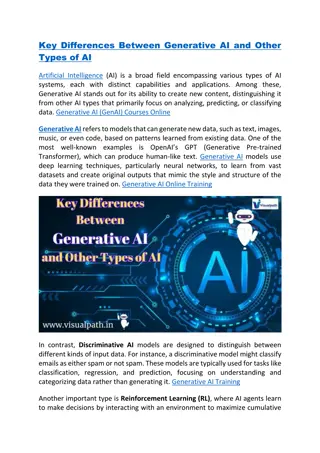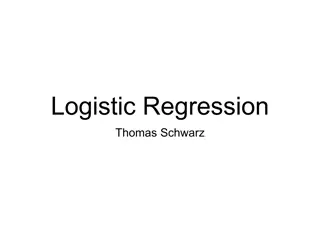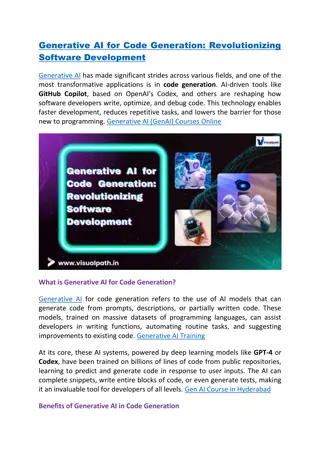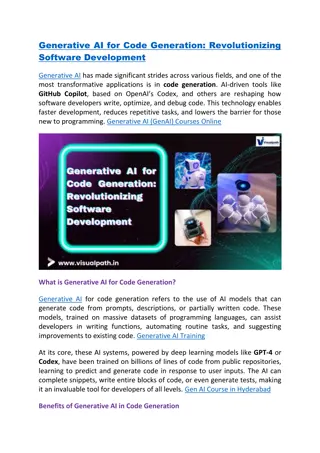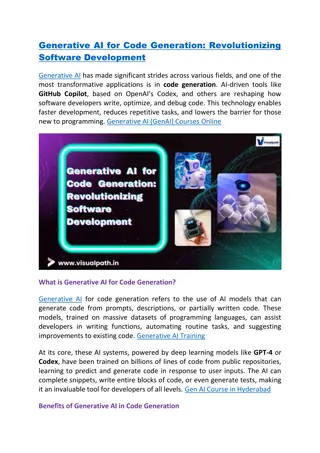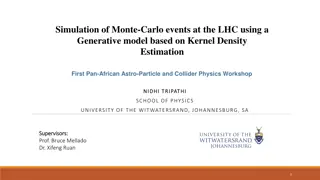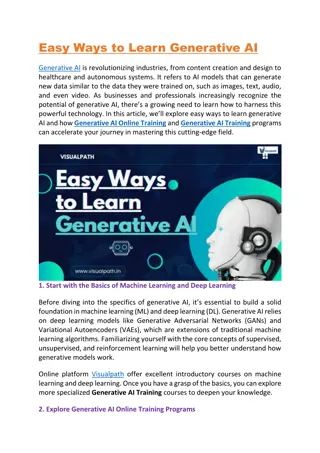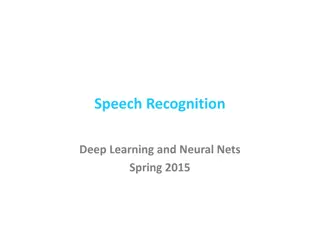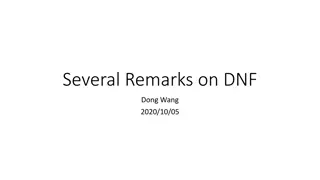Learning Generative and Discriminative Models in Classification
Explore the nuances between generative and discriminative models in classification tasks. Understand how these models learn and predict probabilities to make informed decisions. Differentiate between their approaches in modeling joint probabilities and optimizing classification accuracy. Discover the strengths and limitations of each model type in handling various datasets and feature complexities. Gain insights into building effective classifiers for diverse text analysis applications.
Download Presentation

Please find below an Image/Link to download the presentation.
The content on the website is provided AS IS for your information and personal use only. It may not be sold, licensed, or shared on other websites without obtaining consent from the author.If you encounter any issues during the download, it is possible that the publisher has removed the file from their server.
You are allowed to download the files provided on this website for personal or commercial use, subject to the condition that they are used lawfully. All files are the property of their respective owners.
The content on the website is provided AS IS for your information and personal use only. It may not be sold, licensed, or shared on other websites without obtaining consent from the author.
E N D
Presentation Transcript
Logistic Regression Chapter 5 1 1
Classification Learn: f:X->Y X features Y target classes 2
Generative vs. Discriminative Models Discriminative Generative Learn a model of the joint probability p(d, c) Use Bayes Rule to calculate p(c|d) Build a model of each class; given example, return the model most likely to have generated that example Examples: Naive Bayes, HMM
Naive Bayes Review Features = {I hate love this book} Training I hate this book Love this book What is P(Y|X)? Prior p(Y) Testing hate book Different conditions a = 0 (no smoothing) a = 1 (smoothing)
Generative vs. Discriminative Models Discriminative Generative Learn a model of the joint probability p(d, c) Use Bayes Rule to calculate p(c|d) Build a model of each class; given example, return the model most likely to have generated that example Examples: Naive Bayes, HMM Model p(c|d) directly Class is a function of document vector Find the exact function that minimizes classification errors on the training data Learn boundaries between classes Example: Logistic regression
Discriminative vs. Generative Classifiers Discriminative classifiers are generally more effective, since they directly optimize the classification accuracy. But They are sensitive to the choice of features Plus: easy to incorporate linguistic information Minus: until neural networks, features extracted heuristically Also, overfitting can happen if data is sparse Generative classifiers are the opposite They directly model text, an unnecessarily harder problem than classification
Review Multiclass NB and Evaluation NB tailored to sentiment Generative vs discriminative classifiers 8
Assumptions of Discriminative Classifiers Data examples (documents) are represented as vectors of features (words, phrases, ngrams, etc) Looking for a function that maps each vector into a class. This function can be found by minimizing the errors on the training data (plus other various criteria) Different classifiers vary on what the function looks like, and how they find the function
How to find the weights? Logistic regression is one method Training using optimization Select values for w Compute f(x) Compare f(x) output to gold labels and compute loss Cross-Entropy (Section 5.3) Adjust w 11
What does a logistic regression model look like? Given document instance x and sentiment label y We can propose various features that we think will tell us whether y is + or -: f1(x): Is the word excellent used in x? f2(x): How many adjectives are used in x? f3(x): How many words in x are from the positive list in our sentiment lexicon? ... We then need some way to combine these features to help us predict y 12
A Feature Representation of the Input But where did the feature representation (and interactions) come from? 13
Classification Decision But where did the weights and bias come from? 14
Motivating Logistic Regression, continued if f1(x) + f2(x) + + fn(x) > thresh: return + else return - Problem: not all features are equally important if w0 + w1f1(x) + + wnfn(x) > 0: return + else return Problem: not probabilistic Apply sigmoid function 15
Logistic Regression Similar to Naive Bayes (but discriminative!) Features don t have to be independent Examples of features Anything of use Linguistic and non-linguistic Count of good Count of not good Sentence length
Classification using LR Compute the feature vector x Multiply with weight vector w Compute the logistic sigmoid function
Examples Example 1 x = (2,1,1,1) w = (1,-1,-2,3) z = 2-1-2+3=2 f(z) = 1/(1+e-2) Example 2 x = (2,1,0,1) w = (0,0,-3,0) z = 0 f(z) = 1/(1+e0) = 1/2
Why Sigmoid? First, Linear Regression Regression used to fit a linear model to data where the dependent variable is continuous: Y =b0+b1X1+b2X2+ +bnXn+e Given a set of points (Xi,Yi), we wish to find a linear function (or line in 2 dimensions) that goes through these points. In general, the points are not exactly aligned: Find line that best fits the points
Error Error: Observed value - Predicted value Chart Title 7 6 5 4 Observed Linear (Observed) 3 2 1 0 0 0.5 1 1.5 2 2.5
Logistic Regression Regression used to fit a curve to data in which the dependent variable is binary, or dichotomous Example application: Medicine We might want to predict response to treatment, where we might code survivors as 1 and those who don t survive as 0
Example Observations: For each value of SurvRate, the number of dots is the number of patients with that value of NewOut Regression: Standard linear regression Problem: extending the regression line a few units left or right along the X axis produces predicted probabilities that fall outside of [0,1]
A Better Solution Regression Curve: Sigmoid function! (bounded by asymptotes y=0 and y=1)
Constructing a Learning Algorithm The conditional data likelihood is the probability of the observed Y values in the training data, conditioned on their corresponding X values. We choose parameters w that satisfy w l l w = x w argmax ( | , ) P y l where w = <w0,w1, ,wn> is the vector of parameters to be estimated, yl denotes the observed value of Y in the l th training example, and xl denotes the observed value of X in the l th training example 27
Constructing a Learning Algorithm Equivalently, we can work with the log of the conditional likelihood: w l l w = x w argmax ln ( P y | , ) l This conditional data log likelihood, which we will denote l(W) can be written as ( ) ln ( 1| l = = + = l l l l l l w , ) (1 x w x w )ln ( 0| , ) l y P y y P y Note here we are utilizing the fact that Y can take only values 0 or 1, so only one of the two terms in the expression will be non-zero for any given yl 28
Fitting LR by Gradient Descent Unfortunately, there is no closed form solution to maximizing l(w) with respect to w. Therefore, one common approach is to use gradient descent Beginning with initial weights of zero, we repeatedly update the weights Details optional, see text, but should understand following concepts Loss function Gradient descent Gradient, learning rate, mini-batch training Regularization Overfitting 29
Gradient Descent Learning Rate: the magnitude of the amount to move is the slope (more generally, the gradient) weighted by the learning rate if too high, overshoot minimum if too low, take too long to learn common to begin high, then decrease 30
Some Practical Issues Feature representation want all features to have similar value ranges too many features? feature selection Efficiency Stochastic Gradient Descent / Batching Over-fitting Regularization Classifying more than two categories 31
Mini-batch training Stochastic gradient descent chooses a random example at a time To make movements less choppy, compute gradient over batches of training instances from training set of size m If batch size is m, batch training If batch size is 1, stochastic gradient descent Otherwise, mini batch training (for efficiency) 32
Regularization Weight training can yield models that don t generalize well to test data (i.e., that overfit to training data) To avoid overfitting, a regularization term (various options) is used to penalize large weights L2 quadratic function of the weight values L1 linear function of the weight values 33
Multinomial Logistic Regression More than two classes AKA softmax regression, maxent classifier Instead of sigmoid, use softmax function Instead of having just one set of weights and one set of features, different set of weights and feature vectors for each class label Loss function changes too 34
Summary of Logistic Regression Learns the Conditional Probability Distribution P(y|x) Local Search. Begins with initial weight vector. Modifies it iteratively to maximize an objective function. The objective function is the conditional log likelihood of the data so the algorithm seeks the probability distribution P(y|x) that is most likely given the data. 35
Two Phases Training we train the system (specifically the weights w and b), e.g., using stochastic gradient descent and the cross-entropy loss Test Given a test example x we compute p(y | x) and return the higher probability label y = 1 or y = 0 36
Final Comments In general, NB and LR make different assumptions NB: Features independent given class -> assumption on P(X|Y) LR: Functional form of P(Y|X), no assumption on P(X|Y) LR is optimized no closed-form solution LR is interpretable 37
Summary Logistic regression is a supervised machine learning classifier (discriminative) Use: LR extracts real-valued features from the input, multiplies each by a weight, sums them, and passes the sum through a sigmoid function to generate a probability. A threshold is used to make a decision Learning: The weights (vector w and bias b) are learned from a labeled training set via a loss function that must be minimized, e.g., by using (iterative) gradient descent to find the optimal weights, and regularization to avoid overfitting 38
